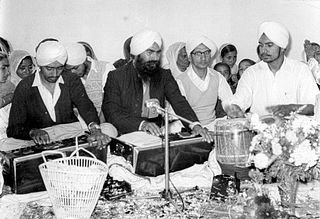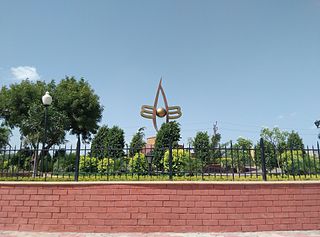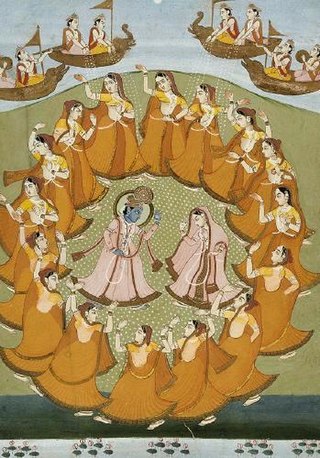Related Research Articles
Dhrupad is a genre in Hindustani classical music from the Indian subcontinent. It is the oldest known style of major vocal styles associated with Hindustani classical music, Haveli Sangeet of Pushtimarg Sampradaya and also related to the South Indian Carnatic tradition. It is a term of Sanskrit origin, derived from dhruva and pada. The roots of Dhrupad are ancient. It is discussed in the Hindu Sanskrit text Natyashastra, and other ancient and medieval Sanskrit texts, such as chapter 33 of Book 10 in the Bhagavata Purana, where the theories of music and devotional songs for Krishna are summarized.

Kirtana, also rendered as Kirtan or Keertan, is a Sanskrit word that means "narrating, reciting, telling, describing" of an idea or story, specifically in Indian religions. It also refers to a genre of religious performance arts, connoting a musical form of narration or shared recitation, particularly of spiritual or religious ideas, native to the Indian subcontinent. A person performing kirtan is known as a kirtankara.
Hindustani classical music is the classical music of the Indian subcontinent's northern regions. It may also be called North Indian classical music or, in Hindustani, shastriya sangeet. The term shastriya sangeet literally means classical music, and is also used to refer to Indian classical music in general. It is played on instruments like the veena, sitar and sarod. Its origins from the 12th century CE, when it diverged from Carnatic music, the classical tradition in South India. While Carnatic music largely uses compositions written in Sanskrit, Kannada, Telugu, Tamil, Malayalam, Hindustani music largely uses compositions written in Hindi-Urdu, Braj, Avadhi, Punjabi, and Rajasthani,.

Nathdwara is a city in the Rajsamand district of the state of Rajasthan, India. It is located in the Aravalli hills, on the banks of the Banas River and is 48 kilometres north-east of Udaipur. Shrinathji, is a swarup of lord Krishna which resembles his 7-year-old "infant" incarnation of Krishna. The deity was originally worshiped at Jatpura, Mathura and was shifted in the year 1672 from Govardhan hill, near Mathura along holy river Yamuna after being retained at Agra for almost six months. Literally, Nathdwara means 'Gateway to Shrinathji (God)'.

Pandit Jasraj was an Indian classical vocalist, belonging to the Mewati gharana. His musical career spanned 75 years resulting in national and international fame, respect and numerous major awards and accolades. His legacy includes memorable performances of classical and semi-classical vocal music, classical and devotional music, albums and film soundtracks, innovations in various genres including Haveli Sangeeth and popularizing the Mewati Gharana – a school of thought in Hindustani classical music. Pandit Jasraj taught music to amateur and professional students in India, Europe, Canada and the United States.

The music of West Bengal includes multiple indigenous musical genres such as Baul, Ramprasadi, Bishnupuri Classical, Kirtan, Shyama Sangeet, Rabindra Sangeet, Nazrul Geeti, Dwijendrageeti, Prabhat Samgiita, Agamani-Vijaya, Patua Sangeet, Gambhira, Bhatiali, Bhawaiya, Bengali Rock.

Swami Haridas was an Indian spiritual poet and classical musician. Credited with a large body of devotional compositions, especially in the Dhrupad style, he is also the founder of the Haridasi school of mysticism, still found today in North India. His work influenced both the classical music and the Bhakti movements of North India, especially those devoted to Krishna's consort Radha.

Shrinathji is a form of Krishna, manifested as a seven-year-old child. The principal shrine of Shrinathji is the Shrinathji Temple in the temple city of Nathdwara, 48 kilometres north-east of Udaipur city in Rajasthan, India. Shrinathji is the central presiding deity of the Vaishnava sect known as Pushtimarg or the Vallabha Sampradaya, established by Vallabhacharya. Shrinathji is worshipped mainly by the followers of Bhakti Yoga and the Vaishnavas in Gujarat and Rajasthan, and Bhatias amongst others.

The Puṣṭimārga or Pushtimarg, also known as Vallabha Sampradāya, is a sect of Vaishnavism. It was founded in the early 16th century by Vallabha (1479–1531) and was later expanded by his descendants, particularly Viṭṭhalanātha. Pushtimarg adherents worship Kr̥ṣṇa, and tradition follows universal-love-themed devotional practices of youthful Krishna which are found in the Bhagavata Purana and those related to pastimes of Govardhana Hill.
Zia Fariduddin Dagar was an Indian classical vocalist belonging to the Dhrupad tradition, the oldest existing form of north Indian classical music. He was part of the Dagar family of musicians.

Shuddadvaita is the "purely non-dual" philosophy propounded by Vallabhacharya, the founding philosopher and guru of the Vallabhā sampradāya or Puśtimārg, a Hindu Vaishnava tradition focused on the worship of Krishna. Vallabhacharya's pure form (nondualist) philosophy is different from Advaita. The Shrinathji temple at Nathdwara, and compositions of eight poets, including Surdas, are central to the worship by the followers of the sect.
Vaishnavism is one of the major Hindu denominations along with Shaivism, Shaktism, and Smartism. It is also called Vishnuism since it considers Vishnu as the sole supreme being leading all other Hindu deities, that is, Mahavishnu. Its followers are called Vaishnavites or Vaishnavas, and it includes sub-sects like Krishnaism and Ramaism, which consider Krishna and Rama as the supreme beings respectively. According to a 2010 estimate by Johnson and Grim, Vaishnavism is the largest Hindu sect, constituting about 641 million or 67.6% of Hindus.

Khamaj is a Hindustani classical Music raga within the Khamaj thaat which is named after it.

Krishnaism is a term used in scholarly circles to describe large group of independent Hindu traditions—sampradayas related to Vaishnavism—that center on the devotion to Krishna as Svayam Bhagavan, Ishvara, Para Brahman, who is the source of all reality, not an avatar of Vishnu. This is its difference from such Vaishnavite groupings as Sri Vaishnavism, Sadh Vaishnavism, Ramaism, Radhaism, Sitaism etc. There is also a personal Krishnaism, that is devotion to Krishna outside of any tradition and community, as in the case of the saint-poet Meera Bai. Leading scholars do not define Krishnaism as a suborder or offshoot of Vaishnavism, considering it at least a parallel and no less ancient current of Hinduism.

The Raslila, also rendered the Rasalila or the Ras dance, is part of a traditional story described in Hindu texts such as the Bhagavata Purana and Gita Govinda, where Krishna dances with Radha and the gopis of Braj. Rasalila has also been a popular theme for other India classical dances including Bharatanatyam, Odissi, Manipuri Raas Leela, Kuchipudi, and Kathak.
The Shree Sanatan Hindu Mandir is the name of two Hindu temples in London, one situated off the Ealing Road in Wembley, in the Brent and the other in Whipps Cross in Waltham Forest near Leytonstone. They are run by charity Shri Vallabh Nidhi UK.

The Shrinathji Temple is a Hindu temple dedicated to Shrinathji located in Nathdwara. It is considered an important pilgrimage centre by Vaishnavas.
Geet (Hindi:गीत) (Urdu:گیت) in Hindi and in Urdu may refer to any poem set to music that can be sung alone or as a duet or in chorus. It has remained popular in all parts of the Indian sub-continent particularly in the Hindi and Urdu speaking areas.

Gokulotsavji Maharaj is a Hindustani classical musician, specializing in Khayal, Dhrupad Dhammar, Prabandh Gayaki and various other ancient indian musical styles. He is also a singer-cum-composer, writer, poet, and musicologist.

Shyam Manohar Goswami also known as Shyamu Bava, is the 16th descendant of Shri Vallabha Acharya, sanskritists, philosopher, spiritual leader, active reformer & guru of the Krishna-centered Pushtimarg sect of Vaishnavism.
References
- 1 2 "Dhrupad and Haveli Sangeet". Indian raga. Retrieved 15 June 2013.
- ↑ "Gujarat and Indian Music". Gujarat online. Retrieved 15 June 2013.
- ↑ "The Story of Hindustani Classical Music". ITC Sangeet research Academy. Retrieved 15 June 2013.
